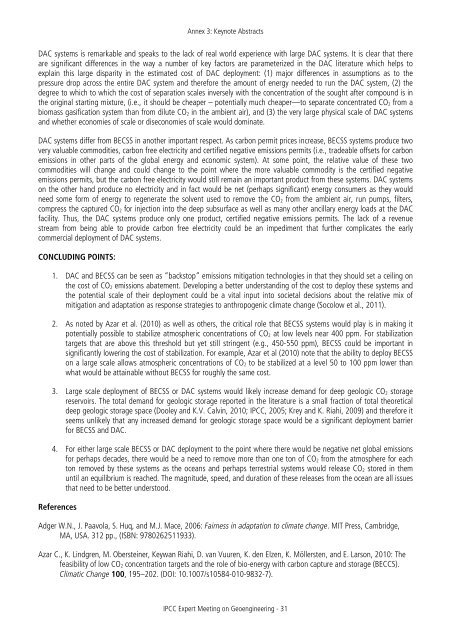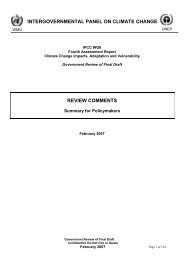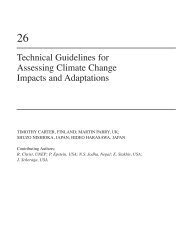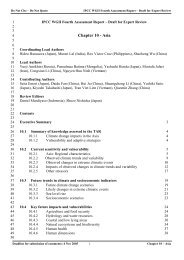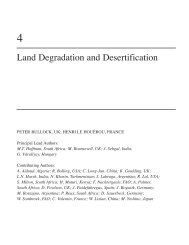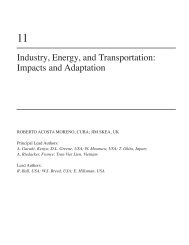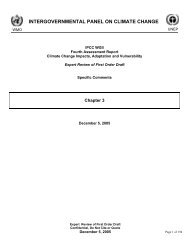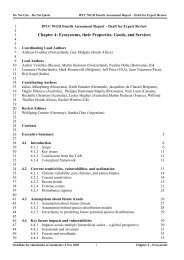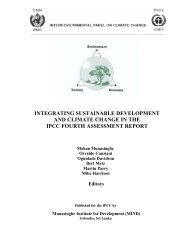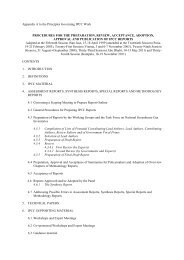IPCC Expert Meeting on Geoengineering
IPCC Expert Meeting on Geoengineering
IPCC Expert Meeting on Geoengineering
Create successful ePaper yourself
Turn your PDF publications into a flip-book with our unique Google optimized e-Paper software.
Annex 3: Keynote Abstracts<br />
DAC systems is remarkable and speaks to the lack of real world experience with large DAC systems. It is clear that there<br />
are significant differences in the way a number of key factors are parameterized in the DAC literature which helps to<br />
explain this large disparity in the estimated cost of DAC deployment: (1) major differences in assumpti<strong>on</strong>s as to the<br />
pressure drop across the entire DAC system and therefore the amount of energy needed to run the DAC system, (2) the<br />
degree to which to which the cost of separati<strong>on</strong> scales inversely with the c<strong>on</strong>centrati<strong>on</strong> of the sought after compound is in<br />
the original starting mixture, (i.e., it should be cheaper – potentially much cheaper—to separate c<strong>on</strong>centrated CO 2 from a<br />
biomass gasificati<strong>on</strong> system than from dilute CO 2 in the ambient air), and (3) the very large physical scale of DAC systems<br />
and whether ec<strong>on</strong>omies of scale or disec<strong>on</strong>omies of scale would dominate.<br />
DAC systems differ from BECSS in another important respect. As carb<strong>on</strong> permit prices increase, BECSS systems produce two<br />
very valuable commodities, carb<strong>on</strong> free electricity and certified negative emissi<strong>on</strong>s permits (i.e., tradeable offsets for carb<strong>on</strong><br />
emissi<strong>on</strong>s in other parts of the global energy and ec<strong>on</strong>omic system). At some point, the relative value of these two<br />
commodities will change and could change to the point where the more valuable commodity is the certified negative<br />
emissi<strong>on</strong>s permits, but the carb<strong>on</strong> free electricity would still remain an important product from these systems. DAC systems<br />
<strong>on</strong> the other hand produce no electricity and in fact would be net (perhaps significant) energy c<strong>on</strong>sumers as they would<br />
need some form of energy to regenerate the solvent used to remove the CO 2 from the ambient air, run pumps, filters,<br />
compress the captured CO 2 for injecti<strong>on</strong> into the deep subsurface as well as many other ancillary energy loads at the DAC<br />
facility. Thus, the DAC systems produce <strong>on</strong>ly <strong>on</strong>e product, certified negative emissi<strong>on</strong>s permits. The lack of a revenue<br />
stream from being able to provide carb<strong>on</strong> free electricity could be an impediment that further complicates the early<br />
commercial deployment of DAC systems.<br />
CONCLUDING POINTS:<br />
1. DAC and BECSS can be seen as “backstop” emissi<strong>on</strong>s mitigati<strong>on</strong> technologies in that they should set a ceiling <strong>on</strong><br />
the cost of CO 2 emissi<strong>on</strong>s abatement. Developing a better understanding of the cost to deploy these systems and<br />
the potential scale of their deployment could be a vital input into societal decisi<strong>on</strong>s about the relative mix of<br />
mitigati<strong>on</strong> and adaptati<strong>on</strong> as resp<strong>on</strong>se strategies to anthropogenic climate change (Socolow et al., 2011).<br />
2. As noted by Azar et al. (2010) as well as others, the critical role that BECSS systems would play is in making it<br />
potentially possible to stabilize atmospheric c<strong>on</strong>centrati<strong>on</strong>s of CO 2 at low levels near 400 ppm. For stabilizati<strong>on</strong><br />
targets that are above this threshold but yet still stringent (e.g., 450-550 ppm), BECSS could be important in<br />
significantly lowering the cost of stabilizati<strong>on</strong>. For example, Azar et al (2010) note that the ability to deploy BECSS<br />
<strong>on</strong> a large scale allows atmospheric c<strong>on</strong>centrati<strong>on</strong>s of CO 2 to be stabilized at a level 50 to 100 ppm lower than<br />
what would be attainable without BECSS for roughly the same cost.<br />
3. Large scale deployment of BECSS or DAC systems would likely increase demand for deep geologic CO 2 storage<br />
reservoirs. The total demand for geologic storage reported in the literature is a small fracti<strong>on</strong> of total theoretical<br />
deep geologic storage space (Dooley and K.V. Calvin, 2010; <str<strong>on</strong>g>IPCC</str<strong>on</strong>g>, 2005; Krey and K. Riahi, 2009) and therefore it<br />
seems unlikely that any increased demand for geologic storage space would be a significant deployment barrier<br />
for BECSS and DAC.<br />
4. For either large scale BECSS or DAC deployment to the point where there would be negative net global emissi<strong>on</strong>s<br />
for perhaps decades, there would be a need to remove more than <strong>on</strong>e t<strong>on</strong> of CO 2 from the atmosphere for each<br />
t<strong>on</strong> removed by these systems as the oceans and perhaps terrestrial systems would release CO 2 stored in them<br />
until an equilibrium is reached. The magnitude, speed, and durati<strong>on</strong> of these releases from the ocean are all issues<br />
that need to be better understood.<br />
References<br />
Adger W.N., J. Paavola, S. Huq, and M.J. Mace, 2006: Fairness in adaptati<strong>on</strong> to climate change. MIT Press, Cambridge,<br />
MA, USA. 312 pp., (ISBN: 9780262511933).<br />
Azar C., K. Lindgren, M. Obersteiner, Keywan Riahi, D. van Vuuren, K. den Elzen, K. Möllersten, and E. Lars<strong>on</strong>, 2010: The<br />
feasibility of low CO 2 c<strong>on</strong>centrati<strong>on</strong> targets and the role of bio-energy with carb<strong>on</strong> capture and storage (BECCS).<br />
Climatic Change 100, 195–202. (DOI: 10.1007/s10584-010-9832-7).<br />
<str<strong>on</strong>g>IPCC</str<strong>on</strong>g> <str<strong>on</strong>g>Expert</str<strong>on</strong>g> <str<strong>on</strong>g>Meeting</str<strong>on</strong>g> <strong>on</strong> <strong>Geoengineering</strong> - 31


